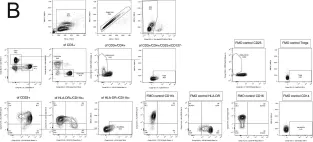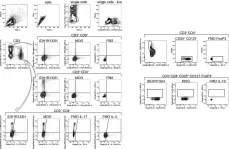Psoriasis is a chronic inflammatory skin disease with a Th17-skewed immune phenotype. Although it has been generally accepted that regulatory T cells (Tregs) in lesional psoriatic skin have functional impairment due to the local inflammatory microenvironment, the molecular properties of skin-homing psoriatic Tregs have not been well explored.
We designed an extensive 39 marker mass cytometry (CyTOF) panel to deeply profile the immune landscape of skin-homing Tregs from 31 people with psoriasis stratified by psoriasis area severity index score as mild (n = 15) to moderate-severe (n = 16) and 32 healthy controls. We further validated the findings with an in-vitro chemokine-mediated Treg migration assay, immunofluorescent imaging of normal and psoriatic lesional skin and analysed public single-cell RNA-sequencing datasets to expand upon our findings into the local tissue microenvironments.
We discovered an overall decrease in CLAhi Tregs and specifically, CLAhiCCR5+ Tregs in psoriasis. Functional markers CD39 and FoxP3 were elevated in psoriatic Tregs. However, CCR7 expression was significantly increased while CCR4 and CLA expression was reduced in psoriatic Tregs and CLAhi Tregs, which was associated with disease severity. Moreover, psoriatic Tregs revealed increased migratory capacity towards CCR7's ligands, CCL19/CCL21. Interrogation of public single-cell RNA sequencing data confirmed reduced expression of skin-trafficking markers in lesional-skin Tregs compared to non-lesioned skin, further substantiated by immunofluorescent staining.
Psoriatic circulating Tregs showed an impaired skin-trafficking phenotype thus leading to insufficient suppression of ongoing inflammation in the lesional skin, expanding upon our current understanding of the impairment of Treg-mediated immunosuppression in psoriasis.
This research was supported by the Basic Science Research Program through the National Research Foundation of Korea funded by the Ministry of Science and Information and Communications Technology (2020R1C1C1014513, 2021R1A4A5032185, 2020R1F1A1073692); and the new faculty research seed money grant of Yonsei University College of Medicine for 2021 (2021-32-0033).
Copyright © 2024 The Author(s). Published by Elsevier B.V. All rights reserved.
Product Citations: 2
In EBioMedicine on 1 February 2024 by Lee, B. H., Bang, Y. J., et al.
-
Homo sapiens (Human)
-
Immunology and Microbiology
A vaccine targeting mutant IDH1 in newly diagnosed glioma.
In Nature on 1 April 2021 by Platten, M., Bunse, L., et al.
Mutated isocitrate dehydrogenase 1 (IDH1) defines a molecularly distinct subtype of diffuse glioma1-3. The most common IDH1 mutation in gliomas affects codon 132 and encodes IDH1(R132H), which harbours a shared clonal neoepitope that is presented on major histocompatibility complex (MHC) class II4,5. An IDH1(R132H)-specific peptide vaccine (IDH1-vac) induces specific therapeutic T helper cell responses that are effective against IDH1(R132H)+ tumours in syngeneic MHC-humanized mice4,6-8. Here we describe a multicentre, single-arm, open-label, first-in-humans phase I trial that we carried out in 33 patients with newly diagnosed World Health Organization grade 3 and 4 IDH1(R132H)+ astrocytomas (Neurooncology Working Group of the German Cancer Society trial 16 (NOA16), ClinicalTrials.gov identifier NCT02454634). The trial met its primary safety endpoint, with vaccine-related adverse events restricted to grade 1. Vaccine-induced immune responses were observed in 93.3% of patients across multiple MHC alleles. Three-year progression-free and death-free rates were 0.63 and 0.84, respectively. Patients with immune responses showed a two-year progression-free rate of 0.82. Two patients without an immune response showed tumour progression within two years of first diagnosis. A mutation-specificity score that incorporates the duration and level of vaccine-induced IDH1(R132H)-specific T cell responses was associated with intratumoral presentation of the IDH1(R132H) neoantigen in pre-treatment tumour tissue. There was a high frequency of pseudoprogression, which indicates intratumoral inflammatory reactions. Pseudoprogression was associated with increased vaccine-induced peripheral T cell responses. Combined single-cell RNA and T cell receptor sequencing showed that tumour-infiltrating CD40LG+ and CXCL13+ T helper cell clusters in a patient with pseudoprogression were dominated by a single IDH1(R132H)-reactive T cell receptor.
-
FC/FACS
-
Homo sapiens (Human)
-
Cancer Research
-
Immunology and Microbiology
In Nature on 1 April 2021 by Platten, M., Bunse, L., et al.
Fig.9.B

-
FC/FACS
-
Homo sapiens (Human)
Collected and cropped from Nature by CiteAb, provided under a CC-BY license
Image 1 of 2
In Nature on 1 April 2021 by Platten, M., Bunse, L., et al.
Fig.4.C

-
FC/FACS
-
Homo sapiens (Human)
Collected and cropped from Nature by CiteAb, provided under a CC-BY license
Image 1 of 2

